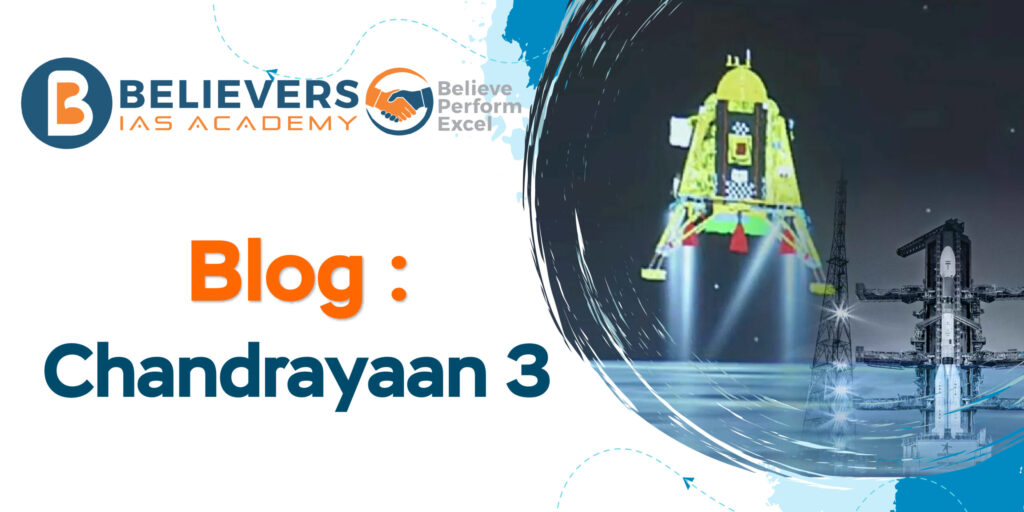The Indian Space Research Organization (ISRO) has launched Chandrayaan-3
The Indian Space Research Organization (ISRO) has launched Chandrayaan-3, the third lunar exploration mission as part of its Chandrayaan program. This program intends to research the Moon and its different attributes, such as the geology, mineralogy, and composition of its surface. A lander named Vikram and a rover named Pragyan were part of the Chandrayaan-2 mission, followed by Chandrayaan-3.
Background of Chandrayaan Programme
The Indian Space Research Organization (ISRO) launched a series of lunar missions under the Chandrayaan program to study the Moon. The program’s objective is to conduct research, examine the lunar surface, and collect information that will further our knowledge of the Moon’s geology, composition, and evolution.
Chandrayaan 1
The Chandrayaan program’s initial mission, Chandrayaan-1, was launched in October 2008. It was the first lunar probe launched from India and had several scientific tools, including an impact probe that found water molecules on the Moon’s surface.
Chandrayaan-2
In July 2019, ISRO launched Chandrayaan-2, building on the success of Chandrayaan-1. It comprised an orbiter, Vikram the lander, and Pragyan the rover. While attempting a soft landing on the Moon’s south pole, the orbiter kept studying the Moon from its position in space. Vikram, the lander, ran into problems during the landing attempt and crashed onto the moon’s surface.
Future Plans and Obstacles
Vikram’s unsuccessful landing during Chandrayaan-2 was a setback for ISRO’s plans to explore the moon. It brought to light the difficulties and difficulties involved in accomplishing a successful soft landing on the Moon. The Indian Space Research Organization (ISRO) declared preparations for Chandrayaan-3 and other upcoming missions despite the setback.
Chandrayaan-3 Announcement
Following the failure of the Chandrayaan-2 landing attempt, ISRO declared that Chandrayaan-3 would go forward. Chandrayaan-3 was designed to correct the flaws that caused the Chandrayaan-2 landing failure and make a successful soft landing on the Moon.
Continuing Lunar Exploration
Chandrayaan-3 was considered an extension of India’s ongoing lunar exploration and research endeavors. ISRO sought to use the lessons learned from Chandrayaan-1 and Chandrayaan-2 to plan and carry out a successful landing mission.
Objectives of Chandrayaan-3
The Chandrayaan-3 mission’s goals, according to ISRO, were as follows: achieving a soft, safe landing of a lander on the Moon’s surface, observing and showcasing the rover’s driving abilities on the Moon, and using the materials found on the lunar surface to conduct and monitor experiments to learn more about the makeup of the Moon.
Components of Chandrayaan-3
- Propulsion Module: The propulsion module is in charge of transporting the lander and rover to the Moon from Earth. Throughout the voyage, it performs the necessary propulsion and trajectory corrections to guarantee the spacecraft reaches lunar orbit precisely.
- Lander (Vikram): The soft lunar surface landing capability of the Vikram lander. It transports the rover and the equipment needed for on-site examination. To facilitate a controlled descent and landing, Vikram’s design has landing legs, landing thrusters, and instrumentation.
- Variable-Thrust Engines: Four variable-thrust engines on the lander of Chandrayaan-3 enable the lander to alter its thrust during descent, improving control and stability.
- Improved Attitude Control: To provide a more controlled landing procedure, the lander’s capacity to control its attitude (orientation) and thrust during all descent stages has been enhanced.
- Laser Doppler Velocimeter(LDV): The lander is equipped with a laser Doppler velocimeter (LDV), which measures its attitude in three directions and helps with precision control during descent.
- Stronger Impact Legs: In comparison to Chandrayaan-2, the lander’s impact legs have been strengthened for greater strength and longevity.
- Better Redundancy: The lander has several backup systems and better instrument redundancy to increase survivability in the event of faults during descent and landing.
- Pragyan rover: This spacecraft is meant to move around the lunar surface while carrying out a variety of scientific investigations. It contains payloads to examine the make-up and characteristics of the lunar rocks and soil.
- Scientific Payloads: To ascertain the chemical and elemental makeup of lunar minerals, the rover is equipped with equipment including the Alpha Particle X-ray spectrometer (APXS) and Laser-Induced Breakdown Spectroscope (LIBS).
Chandrayaan-3 Launch
On July 14, 2023, at 2:35 p.m. IST, Chandrayaan-3 was launched from the Satish Dhawan Space Centre’s Second Launch Pad in Sriharikota, Andhra Pradesh, India, on an LVM3-M4 rocket. It entered an Earth parking orbit with perigee and apogee distances of 170 km and 36,500 km, respectively.
Descent to the Moon
On August 23, 2023, the lander’s four engines ignited in a braking maneuver at a height of 30 kilometers (19 mi) above the Moon as it neared the low point of its orbit. The lander reached a height of 7.2 kilometers (4.5 miles) above the ground after 11.5 minutes; it held this height for roughly 10 seconds before stabilizing itself with eight smaller engines and rotating from a horizontal to a vertical position while continuing its descent. It stayed there for around 30 seconds before resuming its descent and touching down at 12:32 UTC. It then used two of its four engines to slow its descent to approximately 150 meters (490 feet).
Other Space Agencies Involved
The ground stations operated by the European Space Agency and the NASA Deep Space Network (DSN) are involved in supporting Chandrayaan-3. The European Space Agency’s ground stations in Kourou, French Guiana, and the Goonhilly Earth Station in the United Kingdom monitor the satellite’s orbit and transmit telemetry data to ISRO Mission Operations Centre in Bengaluru, India. The NASA DSN provides telemetry and tracking coverage during the powered descent phase of Chandrayaan-3, ensuring a secure lunar landing.

